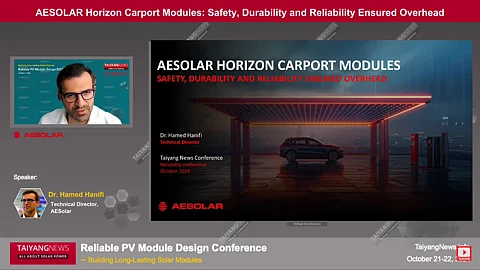

AESOLAR presented the building material grade HORIZON series TOPCon PV carport module at the TaiyangNews Reliable PV Module Design Conference 2024
In place of standard IEC testing protocol, this module series is certified according to building material grade certification standards to mitigate the risk of overhead hazards
This module series, available in 2 models with power output up to 435 W and 590 W, offers an efficiency of up to 22.31%
In recent years, the exponential global adoption of electric vehicles (EVs), driven primarily by efforts to reduce Scope 2 carbon emissions, has resulted in the sale of 16.6 million EVs as of 2024, with China leading the market, followed by the USA and Europe. Charging EVs with residential or commercial carport PV installations – the most cost-effective energy source compared to grid charging or traditional fuels – has fueled the demand for high-efficiency, high-power PV modules tailored for carport applications. Ensuring overhead safety in PV carport systems, coupled with resilience against long-term environmental degradation, highlights the importance of maintaining the quality and reliability of carport PV modules beyond the requirements of IEC 61215 and IEC 61730, the international design and safety standards for conventional silicon PV modules.
At the recent TaiyangNews Reliable PV Module Design Conference 2024, Dr. Hamed Hanifi, Technical Director of AESOLAR presented the building material grade AE HORIZON series TOPCon carport modules (see AESOLAR presentation here).
The HORIZON series carport module, featuring M10-size TOPCon half-cells, boasts an efficiency of up to 22.31%. With dimensions of 1,721 x 1,133 x 30 mm (under 2 m²), it delivers a power output ranging from 415 W to 435 W. Its larger counterpart, exceeding 2 m² in size, provides a power output of up to 590 W. Both modules from this series offer product and performance warranty of up to 30 years, added the company.
The company emphasized the importance of the quality and selection of encapsulation to mitigate the potential UV-induced degradation (UVID), susceptible to delamination and discoloration. It subsequently compromises the PV module’s durability and increases the risk of overhead installation hazards. The in-house enhanced stress test (9x more than IEC) reveals high durability of POE encapsulant compared to EVA under high UV radiations. Mr. Hanifi also noted the potential risk of humidity ingression inside module lamination under the presence of UV and temperature, resulting in corrosion, delamination, and discoloration.
Recognizing the limitations of conventional IEC standards in ensuring the long-term durability and reliability of carport PV modules, as well as addressing overhead safety concerns, the company adopted testing protocols aligned with building-grade material standards. In collaboration with TU Darmstadt, AESOLAR validated the HORIZON series carport module’s resilience against UV, humidity, and temperature in compliance with the DIN ISO 12543-4 standard. According to this standard, which outlines durability testing for laminated and safety glass in building applications, the PV module and a counterpart 30 mm framed laminate without PV cells were subjected to a rigorous test sequence. This included a high-temperature test at 100°C for 16 hours, a two-week humidity test with 100% RH condensation at 50°C, and a 2,000-hour UV radiation test. The modules showed no significant defects, such as bubbles, delamination, or cloudiness, confirming the durability of the polymer stack. The company also reported peel test values averaging 91.26 N/cm – exceeding the required 79 N/cm – validating the lamination quality per DIN EN ISO 8510-2 standards.
Durability against external mechanical impacts, such as hailstones, was verified using the DIN EN 12600 and DIN 18008-1 standards. A 50 kg metal pendulum was used in impact tests on both large-size modules and 30 mm framed laminates without glass. Key observations from these tests include: damage initially occurring on the side opposite the impact, the POE layer effectively retaining glass fragments without detachment, and PV modules with cells exhibiting greater stability than laminates. Furthermore, the PV module underwent mechanical load testing per DIN 18008 standards – Glass in Building: Design and Construction Rules Parts 1 and 2 – and demonstrated sufficient residual load-carrying capacity, ensuring robust performance under external mechanical stresses, according to AESOLAR.
